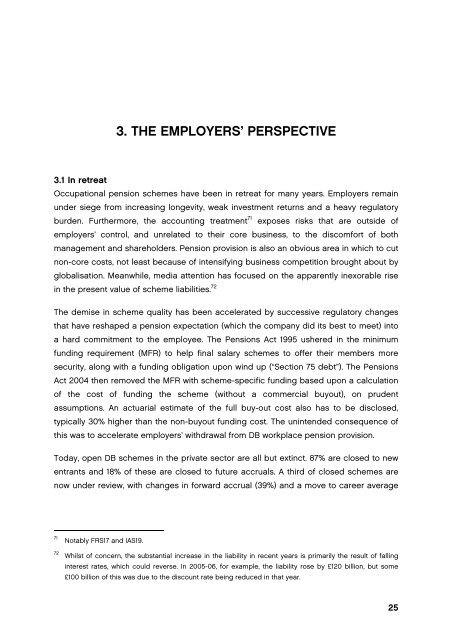Simplification is the key - Centre for Policy Studies
Simplification is the key - Centre for Policy Studies
Simplification is the key - Centre for Policy Studies
You also want an ePaper? Increase the reach of your titles
YUMPU automatically turns print PDFs into web optimized ePapers that Google loves.
3. THE EMPLOYERS’ PERSPECTIVE<br />
3.1 In retreat<br />
Occupational pension schemes have been in retreat <strong>for</strong> many years. Employers remain<br />
under siege from increasing longevity, weak investment returns and a heavy regulatory<br />
burden. Fur<strong>the</strong>rmore, <strong>the</strong> accounting treatment 71 exposes r<strong>is</strong>ks that are outside of<br />
employers’ control, and unrelated to <strong>the</strong>ir core business, to <strong>the</strong> d<strong>is</strong>com<strong>for</strong>t of both<br />
management and shareholders. Pension prov<strong>is</strong>ion <strong>is</strong> also an obvious area in which to cut<br />
non-core costs, not least because of intensifying business competition brought about by<br />
global<strong>is</strong>ation. Meanwhile, media attention has focused on <strong>the</strong> apparently inexorable r<strong>is</strong>e<br />
in <strong>the</strong> present value of scheme liabilities. 72<br />
The dem<strong>is</strong>e in scheme quality has been accelerated by successive regulatory changes<br />
that have reshaped a pension expectation (which <strong>the</strong> company did its best to meet) into<br />
a hard commitment to <strong>the</strong> employee. The Pensions Act 1995 ushered in <strong>the</strong> minimum<br />
funding requirement (MFR) to help final salary schemes to offer <strong>the</strong>ir members more<br />
security, along with a funding obligation upon wind up (“Section 75 debt”). The Pensions<br />
Act 2004 <strong>the</strong>n removed <strong>the</strong> MFR with scheme-specific funding based upon a calculation<br />
of <strong>the</strong> cost of funding <strong>the</strong> scheme (without a commercial buyout), on prudent<br />
assumptions. An actuarial estimate of <strong>the</strong> full buy-out cost also has to be d<strong>is</strong>closed,<br />
typically 30% higher than <strong>the</strong> non-buyout funding cost. The unintended consequence of<br />
th<strong>is</strong> was to accelerate employers’ withdrawal from DB workplace pension prov<strong>is</strong>ion.<br />
Today, open DB schemes in <strong>the</strong> private sector are all but extinct. 87% are closed to new<br />
entrants and 18% of <strong>the</strong>se are closed to future accruals. A third of closed schemes are<br />
now under review, with changes in <strong>for</strong>ward accrual (39%) and a move to career average<br />
71<br />
72<br />
Notably FRS17 and IAS19.<br />
Whilst of concern, <strong>the</strong> substantial increase in <strong>the</strong> liability in recent years <strong>is</strong> primarily <strong>the</strong> result of falling<br />
interest rates, which could reverse. In 2005-06, <strong>for</strong> example, <strong>the</strong> liability rose by £120 billion, but some<br />
£100 billion of th<strong>is</strong> was due to <strong>the</strong> d<strong>is</strong>count rate being reduced in that year.<br />
25

















